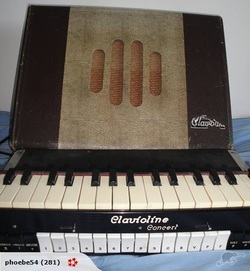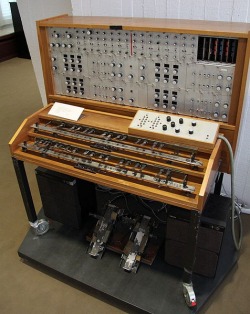Vintage Synths
Vintage synths & keyboards links
http://www.till.com/articles/index.html - a collection of various synthesiser and vintage keyboard sites. Some contain circuit schematics.
The Mellotron - Rick Wakeman tells the Story of the Mellotron (this was produced for radio). There is also a snippet from Mick Pinder (Moody Blues) and one from Paul McCartney.
Mellodrama - A great DVD on the history of the Mellotron, and the original tape based sampler; the Chamberlin.
The Optigan - for all things Optigan. This was a cheap instrument that used optical discs instead of tapes. It was made by the toy manufacturer Mattel in the 70s. The main advantage was that sounds could be sustained for as long as you held the key, rather than the 8 second limit on the Mellotron.
The Shape of Things that Hum - a series of BBC Documentaries from 2001 put together here. These instruments are featured:
Mini Moog 00:12
Vocoder 09:45
DX7 20:19
Fairlight 30:27
Simmons 40:12
TB-303 50:27
TB-808 1:01:01
Akai Sampler 1:11:20
Novachord Restoration Project - Phil Cirocco spent over a year doing a full restoration of a Hammond Novachord. Included are some sound files where you can hear the awesome sound effects and atmospheric pads it is capable of.
The Mellotron - Rick Wakeman tells the Story of the Mellotron (this was produced for radio). There is also a snippet from Mick Pinder (Moody Blues) and one from Paul McCartney.
Mellodrama - A great DVD on the history of the Mellotron, and the original tape based sampler; the Chamberlin.
The Optigan - for all things Optigan. This was a cheap instrument that used optical discs instead of tapes. It was made by the toy manufacturer Mattel in the 70s. The main advantage was that sounds could be sustained for as long as you held the key, rather than the 8 second limit on the Mellotron.
The Shape of Things that Hum - a series of BBC Documentaries from 2001 put together here. These instruments are featured:
Mini Moog 00:12
Vocoder 09:45
DX7 20:19
Fairlight 30:27
Simmons 40:12
TB-303 50:27
TB-808 1:01:01
Akai Sampler 1:11:20
Novachord Restoration Project - Phil Cirocco spent over a year doing a full restoration of a Hammond Novachord. Included are some sound files where you can hear the awesome sound effects and atmospheric pads it is capable of.
The Theremin
The most popular vintage synthesiser, and it doesn't have a keyboard. In fact the Theremin has no moving parts, and there is no contact at all between the player and the instrument. Spooky, possums! Here is some information about this strange instrument:
The Intriguing Theremin - an Interent Radio program.
Theremin.info website
Theremin World website
Theremin: An Electronic Odyssey - a 1994 video documentary, featuring Clara Rockmore, Bob Moog, Leon Theremin.
The Intriguing Theremin - an Interent Radio program.
Theremin.info website
Theremin World website
Theremin: An Electronic Odyssey - a 1994 video documentary, featuring Clara Rockmore, Bob Moog, Leon Theremin.
The Clavioline

This has come up for sale on Trade Me. It is a Selmer Clavioline from 1954, and was invented by a Frenchman, Constant Martin. The manufacturer's claims that "every orchestral instrument could be imitated" were a bit wide of the mark, but the instrument did feature on a couple of top pop songs. The Tornadoes used it on their huge 1962 hit, 'Telstar' (which was the first single by a British band to reach no.1 in the U.S.). The Beatles 'Baby You're A Rich Man' (Yellow Submarine) has it making a twangy sound. Del Shannon's hit 'Runaway' has a very similar sound, but apparently it was not a Clavioline. An interesting fact about this instrument is that is was designed to be attached under a piano keyboard (or could go on its own stand).
You can read more about it on this 2007 SOS article, and information about the circuits and restoration of a Clavioline is available here.
The Trautonium
Inventor: Dr Freidrich Adolf Trautwein
Country: Germany
Prototype exhibited: 1930
Manufactured: 1932-35
Notable performers: Paul Hindemith, Oskar Sala
Principle of operation: electronic (valve oscillation)
Theory of Operation:
The Trautonium worked by the performer completing the circuit of an neon tube oscillator. The pitch range was 3 octaves, and it had a transpose switch.
The voice architecture was somewhat similar to a modular 4 oscillator monophonic synth in which all oscillators are synced (the oscillator signal split into 4 sub-harmonic generators, alternately one signal could be derived from an independent oscillator.
The raw squarewave was converted to a sawtooth wave before going to separate formant filters for each tone (ie subtractive synthesis), and finally to 4 AD envelope generators.
There was also a foot volume pedal.
In Use:
The Trautonium required it’s own performance technique. A resistance wire was pushed onto a metal rail marked off in semitones. Glissando was possible by sliding a finger along the wire. Micro-tonal intervals were also possible. As the resistive scaling of the wire was linear it was probably not too difficult to control these effects while sticking to a sense of tune.
The most active user of the instrument was Oskar Sala. It is the Trautonium we hear during the scary scene in Hitchcock’s “The Birds”.
The Trautonium’s successor; the Mixturtrautonium gave a player a more positive pitch action by adding metal levers at set intervals. It also replaced the valve circuits with a solid-state design, which gave (for better or worse) accurate pitch definition.
My Thoughts:
I think the Trautonium is a good example of what a synthesiser ought to be. It could generate unnatural sounds, whereas it couldn’t realistically reproduce natural instruments. Listening to the sound samples on www.obsolete.com indicates that it was capable of a broad range of sounds, including percussive effects.
The Trautonium’s method of control was unusual (although not unique - the Hellertion had a similar control in 1929). This is a bit different to the direction that synths took later on (early on in the case of the Ondes-Martenot). For example; the Moog synthesiser was (wrongly) acclaimed to be able to make any sound imaginable, while being interfaced to a piano keyboard! (Don Bushla’s first synths were at least non-keyboard, but without commercial success). I remember many discussions I had in the 70s trying to explain why a synthesiser is not an electronic organ (“but it’s a got a keyboard…” people would say). Eventually it became a mute point because many synth manufacturers wanted a synth to look and behave like an organ to make it into a consumer product.
The Trautonium is perhaps the first truly electronic music synthesiser. In another 30 years Robert Moog would add voltage control, but the oscillator to filter to amplifier signal path had been established.
References:
http://www.obsolete.com/120_years/machines/trautonium/index.html
http://www.musicaltimes.co.uk/archive/0201/sala.html
The Art of Electronic Music (Keyboard Books, 1984)
http://www.youtube.com/watch?list=RD-tQQEChMq1A&v=TQ4wGucalpc
http://www.youtube.com/watch?v=-tQQEChMq1A
http://www.youtube.com/watch?v=UTalzWzGACQ

